Effects of Aerosol Number Concentration and Updraft Velocity on Relative Dispersion during the Collision–Coalescence Growth Stage of Warm Clouds
Abstract
:1. Introduction
2. Description of the Model and Simulation Setup
2.1. The Model Description
2.2. Model Initialization
2.3. Experimental Schemes Design
3. Results and Discussion
3.1. Selection of the Domain and the Time Division of Growth Stages
3.2. Temporal Changes in Cloud Microphysics
3.3. Joint Effects of Updraft Velocity and Aerosol Loadings on Relative Dispersion
3.4. Variation in Relative Dispersion with Updraft Velocity and Aerosol Number Concentration
3.5. Joint Dependence of the Relationship between Nc and ε on Na and w
4. Conclusions
Author Contributions
Funding
Institutional Review Board Statement
Informed Consent Statement
Data Availability Statement
Acknowledgments
Conflicts of Interest
References
- Albrecht, B.A. Aerosols, cloud microphysics, and fractional cloudiness. Science 1989, 245, 1227–1230. [Google Scholar] [CrossRef]
- Jia, H.; Ma, X.; Yu, F.; Liu, Y.; Yin, Y. Distinct impacts of increased aerosols on cloud droplet number concentration of stratus/stratocumulus and cumulus. Geophys. Res. Letts. 2019, 46, 13517–13525. [Google Scholar] [CrossRef]
- Wang, Y.; Lu, C.; Niu, S.; Lv, J.; Jia, X.; Xu, X.; Zhang, L.; Yan, S. Diverse dispersion effects and parameterization of relative dispersion in urban fog in eastern China. J. Geophys. Res. Atmos. 2023, 128, e2022JD037514. [Google Scholar] [CrossRef]
- Ackerman, A.S.; Toon, O.B.; Taylor, J.P.; Johnson, D.W.; Hobbs, P.V.; Ferek, R.J. Effects of aerosols on cloud albedo: Evaluation of Twomey’s parameterization of cloud susceptibility using measurements of ship tracks. J. Atmos. Sci. 2000, 57, 2684–2695. [Google Scholar] [CrossRef]
- Feingold, G.; Boers, R.; Stevens, B.; Cotton, W.R. A modeling study of the effect of drizzle on cloud optical depth and susceptibility. J. Geophys. Res. 1997, 102, 13527–13534. [Google Scholar] [CrossRef]
- Liu, Y.; Daum, P. Indirect warming effect from dispersion forcing. Nature 2002, 419, 580–581. [Google Scholar] [CrossRef]
- Lu, M.; Feingold, G.; Jonsson, H.H.; Chuang, P.Y.; Gates, H.; Flagan, R.C.; Seinfeld, J.H. Aerosol-cloud relationships in continental shallow cumulus. J. Geophys. Res. 2008, 113, D15201. [Google Scholar] [CrossRef]
- Lu, C.; Liu, Y.; Niu, S.; Vogelmann, A.M. Observed impacts of vertical velocity on cloud microphysics and implications for aerosol indirect effects. Geophys. Res. Lett. 2012, 3. [Google Scholar] [CrossRef]
- Peng, Y.; Lohmann, U. Sensitivity study of the spectral dispersion of the cloud droplet size distribution on the indirect aerosol effect. Geophys. Res. Lett. 2003, 30, 1507. [Google Scholar] [CrossRef]
- Tas, E.; Koren, I.; Altaratz, O. On the sensitivity of droplet size relative dispersion to warm cumulus cloud evolution. Geophys. Res. Lett. 2012, 39, L13807. [Google Scholar] [CrossRef]
- Tas, E.; Teller, A.; Altaratz, O.; Axisa, D.; Bruintjes, R.; Levin, Z.; Koren, I. The relative dispersion of cloud droplets: Its robustness with respect to key cloud properties. Atmos. Chem. Phys. 2015, 15, 2009–2017. [Google Scholar] [CrossRef]
- Jones, A.; Slingo, A. Predicting cloud-droplet effective radius and indirect sulphate aerosol forcing using a general circulation model. Q. J. R. Meteorol. Soc. 1996, 122, 1573–1595. [Google Scholar] [CrossRef]
- Kiehl, J.T.; Schneider, T.L.; Rasch, P.J.; Barth, M.C.; Wong, J. Radiative forcing due to sulfate aerosols from simulations with the National Center for Atmospheric Research Community Climate Model, Version 3. J. Geophys. Res. 2000, 105, 1441–1457. [Google Scholar] [CrossRef]
- Liu, Y.; Daum, P.H. Spectral dispersion of cloud droplet size distributions and the parameterization of cloud droplet effective radius. Geophys. Res. Lett. 2000, 27, 1903–1906. [Google Scholar] [CrossRef]
- Wang, Y.; Niu, S.; Lu, C.; Liu, Y.; Chen, J.; Yang, W. An observational study on cloud spectral width in North China. Atmosphere 2019, 10, 109. [Google Scholar] [CrossRef]
- Ghan, S.J.; Easter, R.C.; Chapman, E.G.; Abdul-Razzak, H.; Zhang, Y.; Leung, L.R.; Laulainen, N.S.; Saylor, R.D.; Zaveri, R.A. A physically based estimate of radiative forcing by anthropogenic sulfate aerosol. J. Geophys. Res. 2001, 106, 5279–5293. [Google Scholar] [CrossRef]
- Kumar, B.; Götzfried, P.; Suresh, N.; Schumacher, J.; Shaw, R.A. Scale dependence of cloud microphysical response to turbulent entrainment and mixing. J. Adv. Model. 2018, 10, 2777–2785. [Google Scholar] [CrossRef]
- Pandithurai, G.; Dipu, S.; Prabha, T.V.; Maheskumar, R.S.; Kulkarni, J.R.; Goswami, B.N. Aerosol effect on droplet spectral dispersion in warm continental cumuli. J. Geophys. Res. 2012, 117, D16202. [Google Scholar] [CrossRef]
- Chen, J.; Liu, Y.; Zhang, M.; Peng, Y. New understanding and quantification of the regime dependence of aerosol-cloud interaction for studying aerosol indirect effects. Geophys. Res. Lett. 2016, 43, 1780–1787. [Google Scholar] [CrossRef]
- Chandrakar, K.K.; Cantrell, W.; Kostinski, A.B.; Shaw, R.A. Dispersion aerosol indirect effect in turbulent clouds: Laboratory measurements of effective Radius. Geophys. Res. Lett. 2018, 45, 10738–10745. [Google Scholar] [CrossRef]
- Guo, X.H.; Lu, C.S.; Zhao, T.L.; Liu, Y.G.; Zhang, G.J.; Luo, S. Observational study of the relationship between entrainment rate and relative dispersion in deep convective clouds. Atmos. Res. 2018, 199, 186–192. [Google Scholar] [CrossRef]
- Liu, Y.G.; Daum, P.; Guo, H.; Peng, Y.R. Dispersion bias, dispersion effect, and the aerosol–cloud conundrum. Environ. Res. Lett. 2008, 3, 045021. [Google Scholar] [CrossRef]
- Wang, X.F.; Xue, H.W.; Fang, W.; Zheng, G.G. A study of shallow cumulus cloud droplet dispersion by large eddy simulations. Acta Meteorol. Sin. 2011, 25, 166–175. [Google Scholar] [CrossRef]
- Lu, M.L.; Seinfeld, J.H. Effect of aerosol number concentration on cloud droplet dispersion: A large-eddy simulation study and implications for aerosol indirect forcing. J. Geophys. Res. 2006, 111, D0027. [Google Scholar] [CrossRef]
- Desai, N.; Glienke, S.; Fugal, J.; Shaw, R.A. Search for microphysical signatures of stochastic condensation in marine boundary layer clouds using airborne digital holography. J. Geophys. Res. 2019, 124, 2739–2752. [Google Scholar] [CrossRef]
- Reisin, T.; Levin, Z.; Tzivion, S. Rain production in convective clouds as simulated in an axisymmetric model with detailed microphysics. Part I: Description of the model. J. Atmos. Sci. 1996, 53, 497–519. [Google Scholar] [CrossRef]
- Yin, Y.; Chen, L. The effects of heating by transported dust layers on cloud and precipitation: A numerical study. Atmos. Chem. Phys. 2007, 7, 3497–3505. [Google Scholar] [CrossRef]
- Wang, Q. Parameterization Scheme for Hygroscopicity of Aerosol in Huang Mountain of China and Its Influence on Microphysical Characteristics of Clouds. Master’s Thesis, Nanjing University of information Science and Technology, Nanjing, China, 2016. [Google Scholar]
- Shupe, M.D.; Kollias, P.; Persson, P.O.; McFarquhar, G.M. Vertical Motions in Arctic Mixed-Phase Stratiform Clouds. J. Atmos. Sci. 2008, 65, 1304–1322. [Google Scholar] [CrossRef]
- Huang, X.Y.; Lu, l.; Hong, T.; Mei, Y.; Yang, M. A case study on the retrieval of microphysical parameters and in-cloud stratus turbulent dissipa-tion rate by millimeter-wave cloud radar measurement. Trans. Atmos. Sci. 2020, 43, 908–916. (In Chinese) [Google Scholar] [CrossRef]
- Pruppacher, H.R.; Klett, J.D.; Wang, P.K. Microphysics of Clouds and Precipitation. Aerosol Sci. Technol. 1998, 28, 381–382. [Google Scholar] [CrossRef]
- Wang, Y.G.; Geerts, B. Composite Vertical Structure of Vertical Velocity in Nonprecipitating Cumulus Clouds. Mon. Weather Rev. 2013, 141, 1673–1692. [Google Scholar] [CrossRef]
- Kollias, P.; Albrecht, B.A.; Lhermitte, R.; Savtchenko, A. Radar Observations of Updrafts, Downdrafts, and Turbulence in Fair-Weather Cumuli. J. Atmos. Sci. 2001, 58, 1750–1766. [Google Scholar] [CrossRef]
- Takeda, T. Evolution of a precipitating cloud and cloud droplets. Pure Appl. Geophys. 1975, 113, 891–907. [Google Scholar] [CrossRef]
- Feingold, G.; McComiskey, A.; Rosenfeld, D.; Sorooshian, A. On the relationship between cloud contact time and precipitation susceptibility to aerosol. J. Geophys. Res. Atmos. 2013, 118, 10544. [Google Scholar] [CrossRef]
- Lee, H.; Fridlind, A.M.; Ackerman, A.S. An Evaluation of Size-Resolved Cloud Microphysics Scheme Numerics for Use with Radar Observations. Part II: Condensation and Evaporation. J. Atmos. Sci. 2021, 78, 1629–1645. [Google Scholar] [CrossRef]
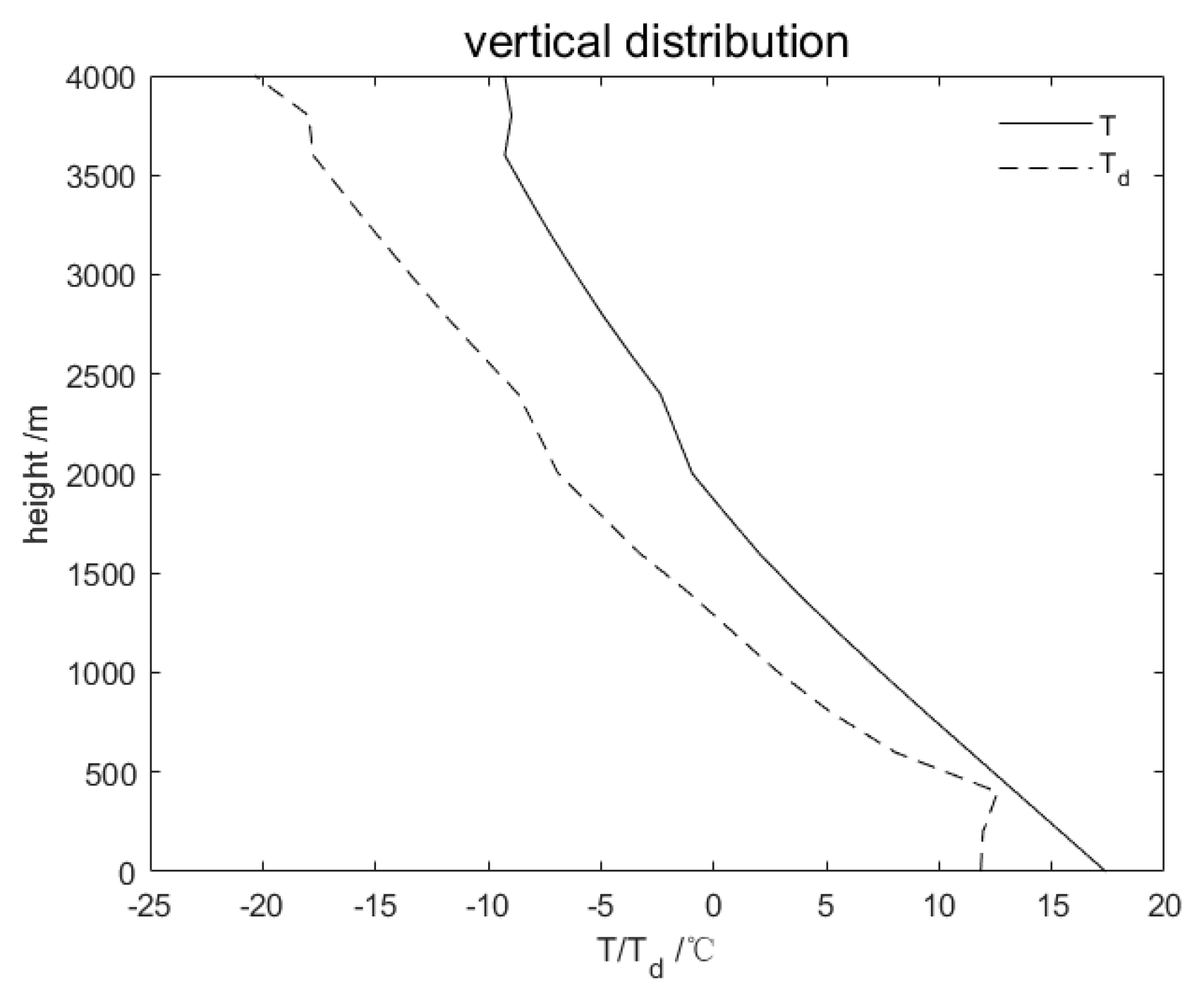
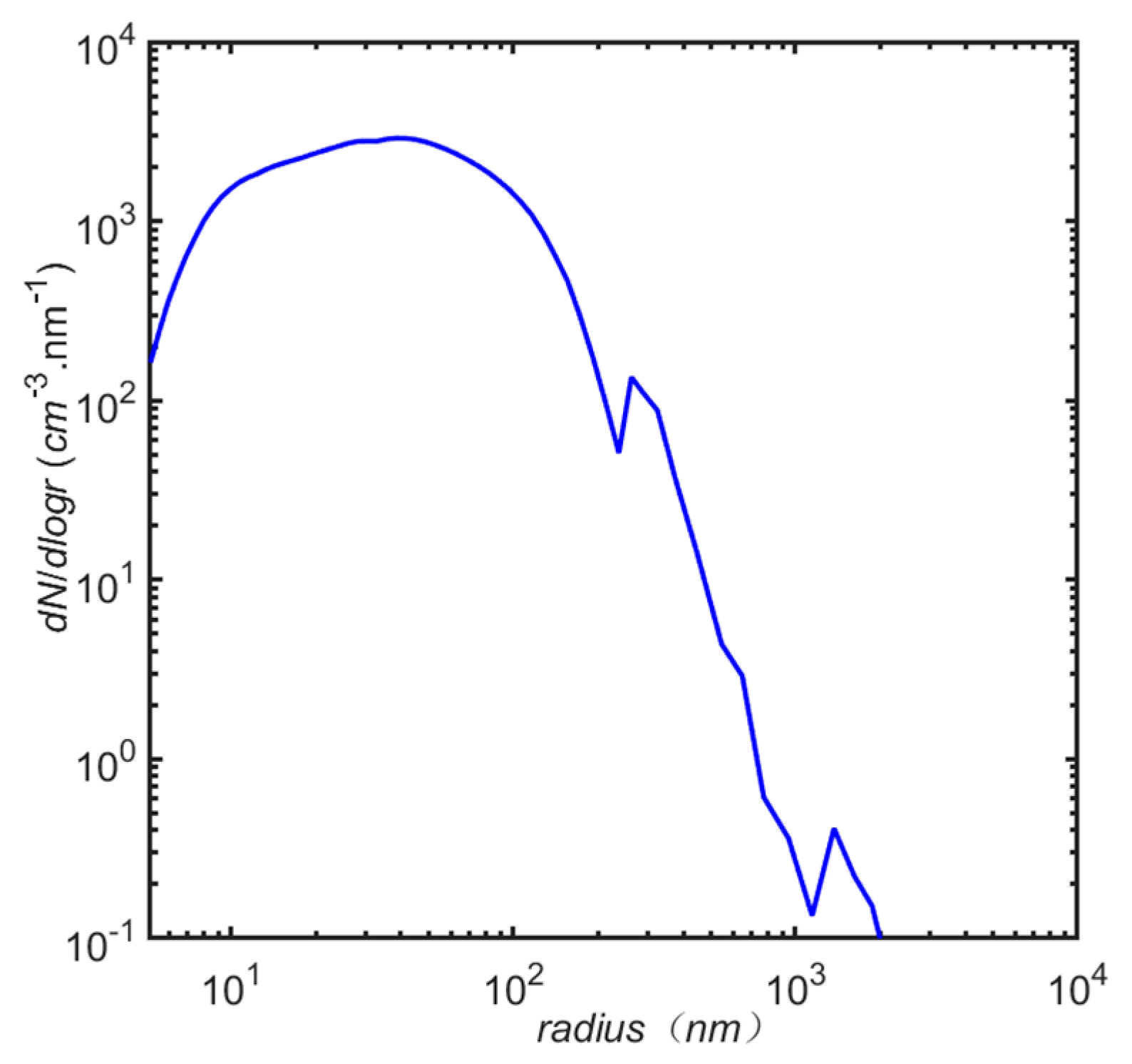
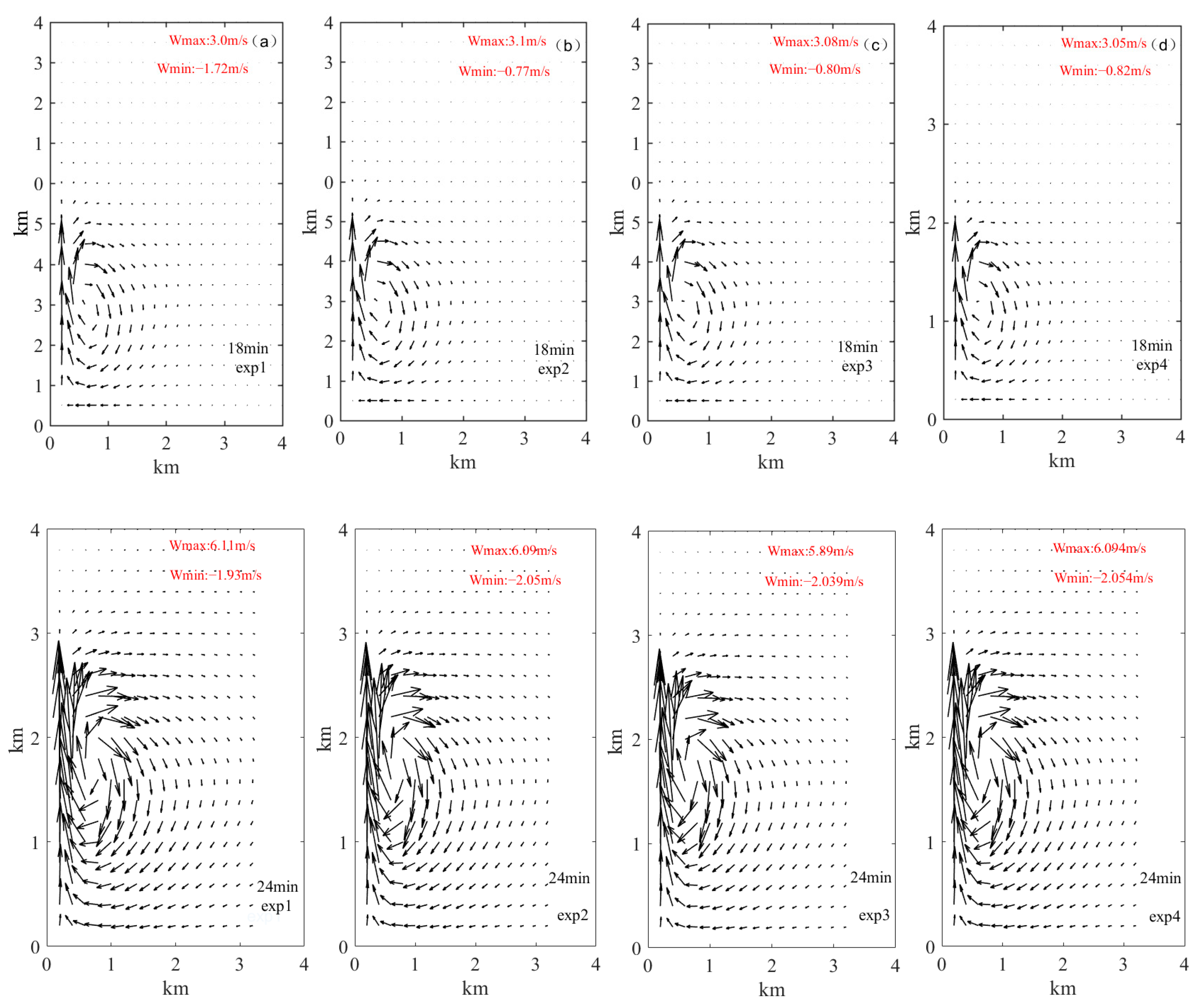
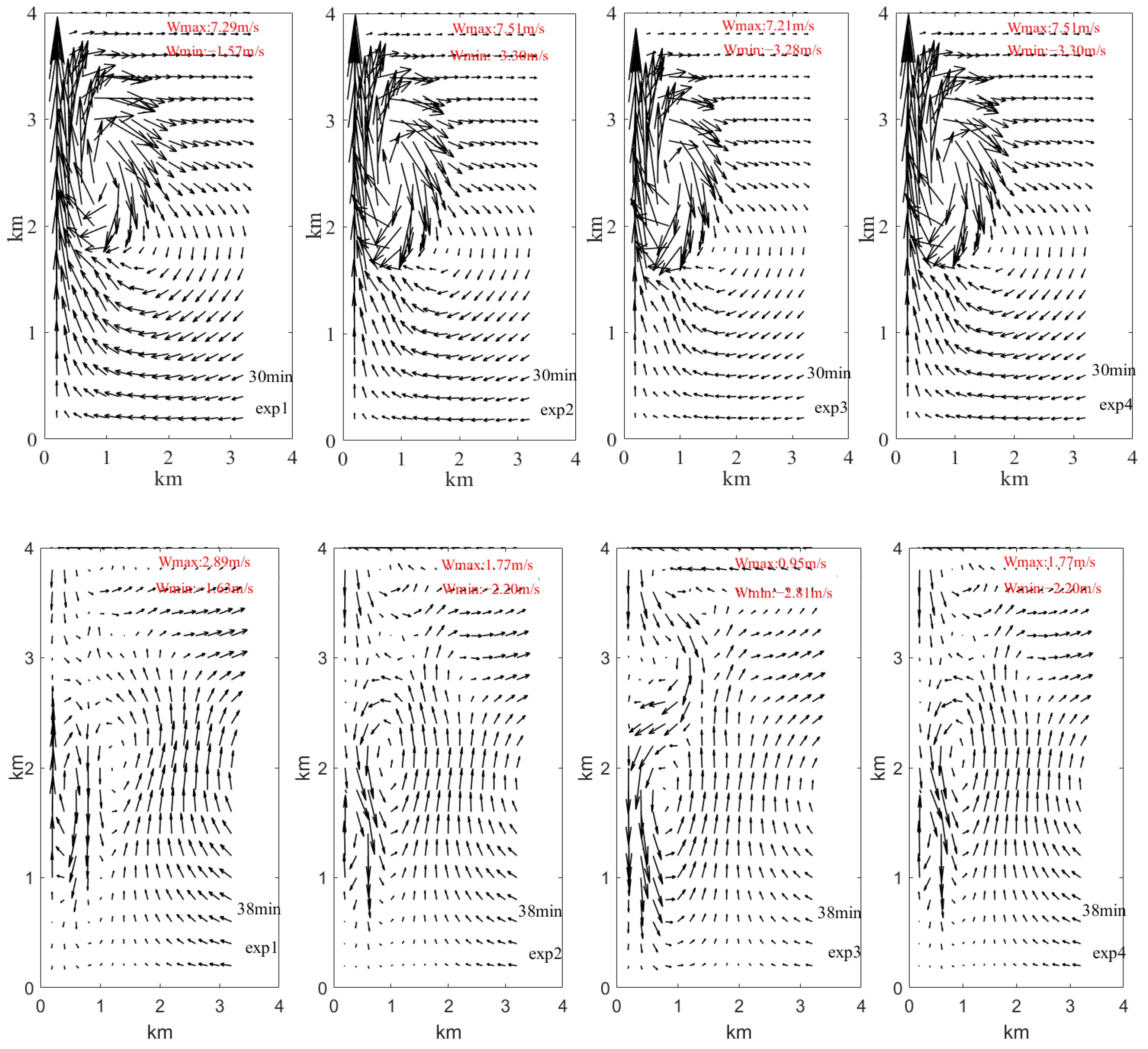
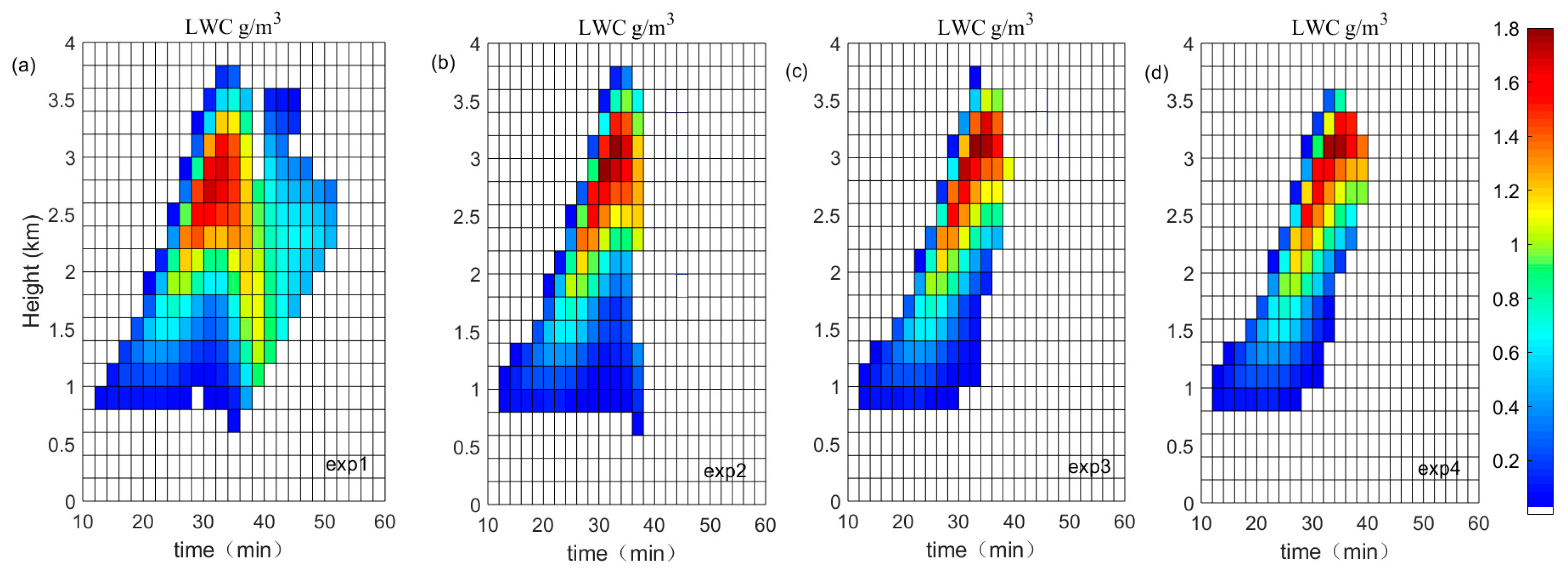


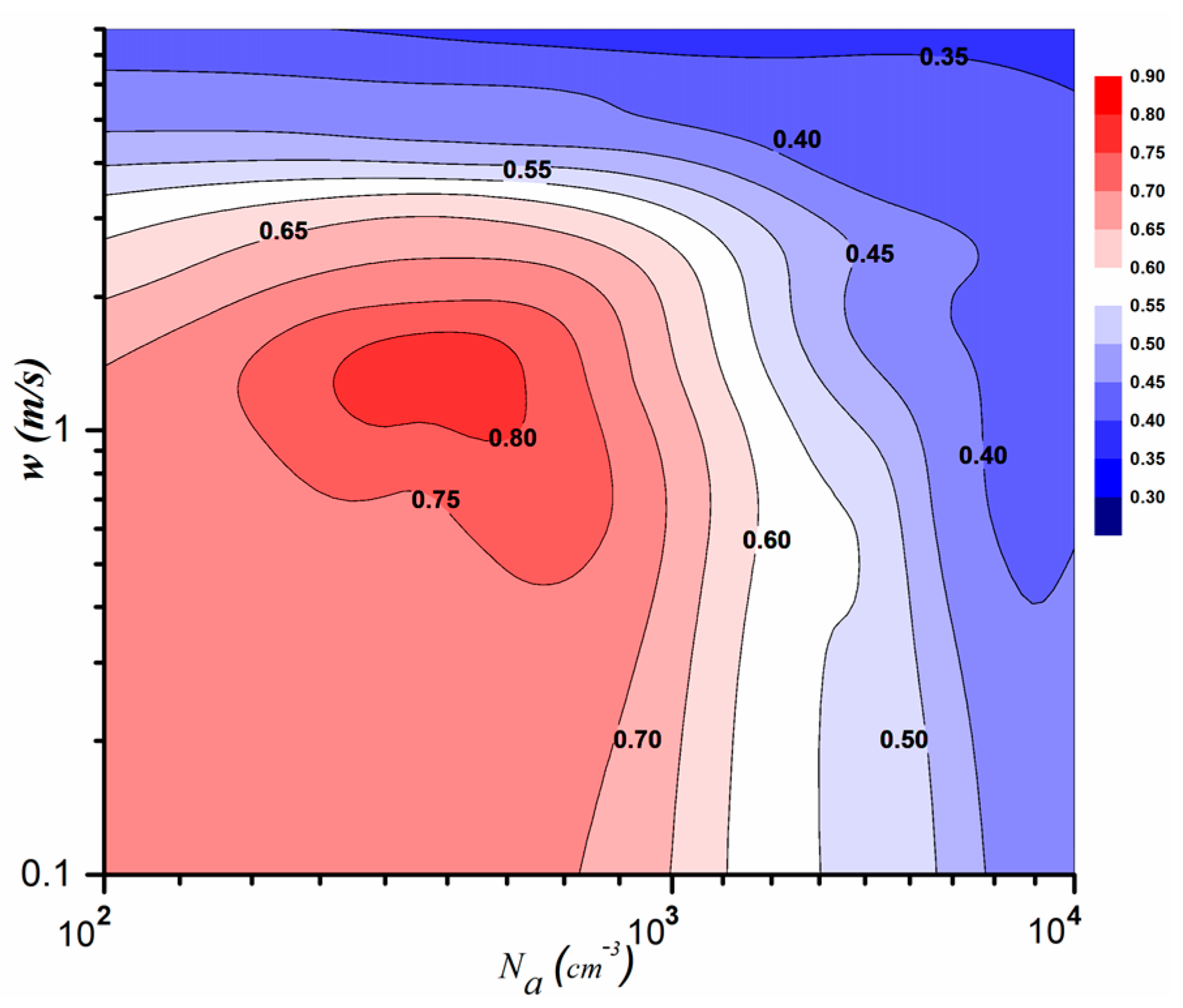
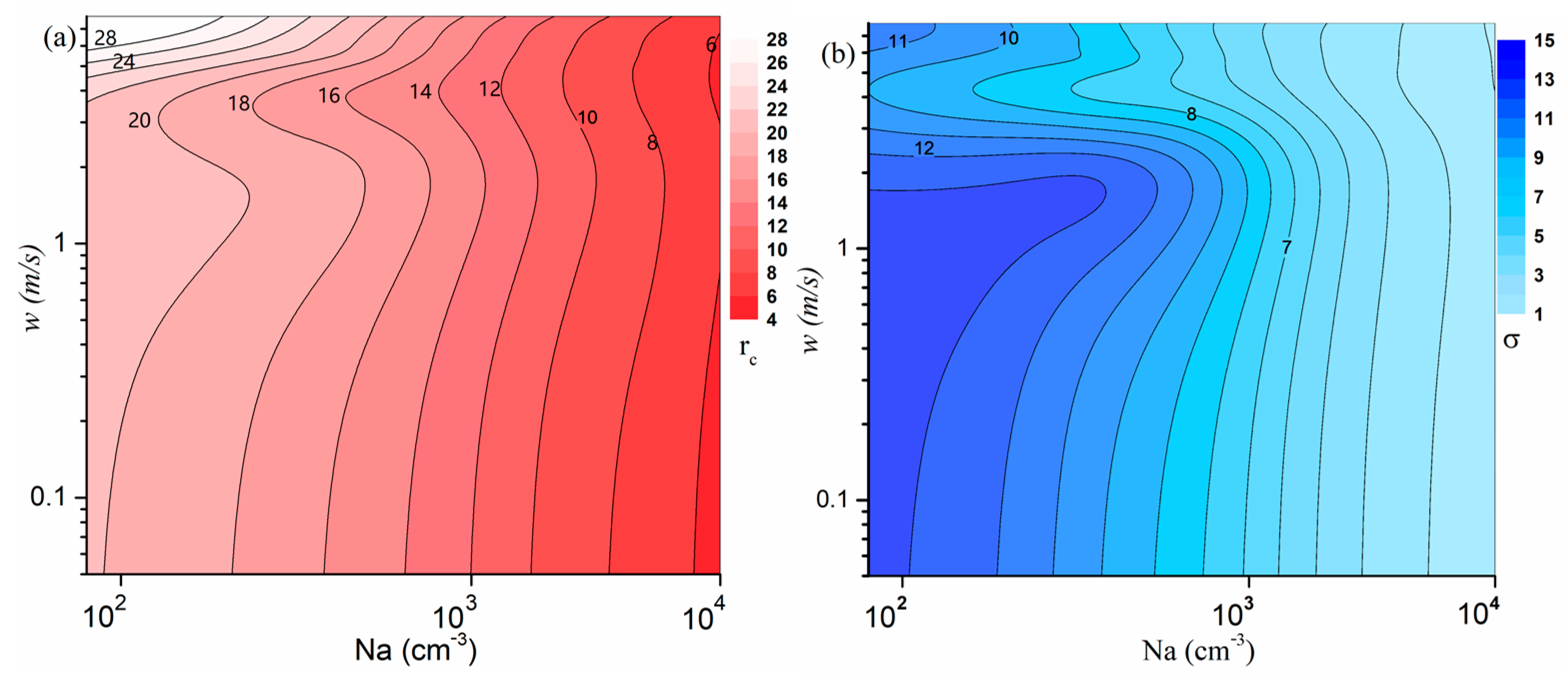


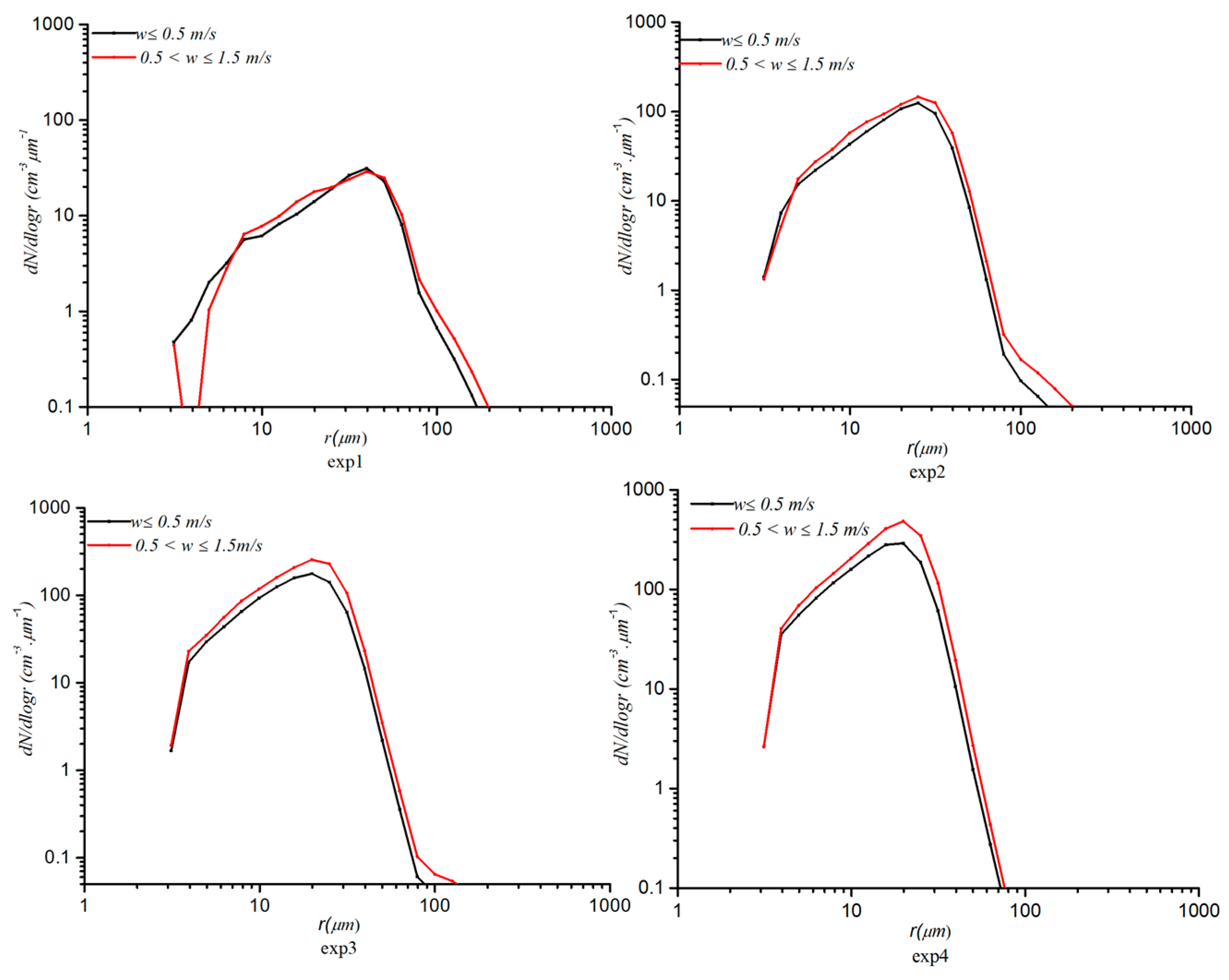
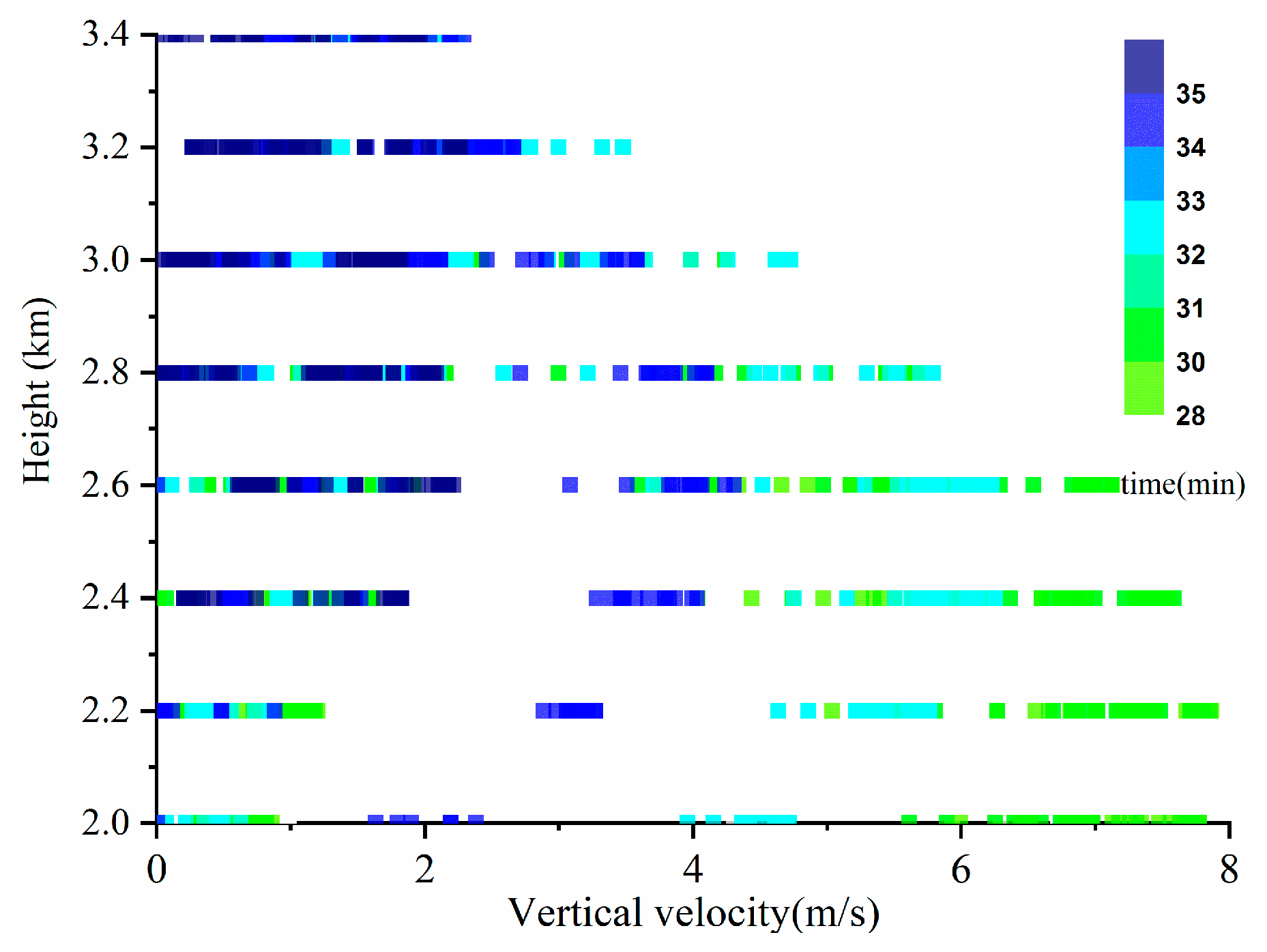
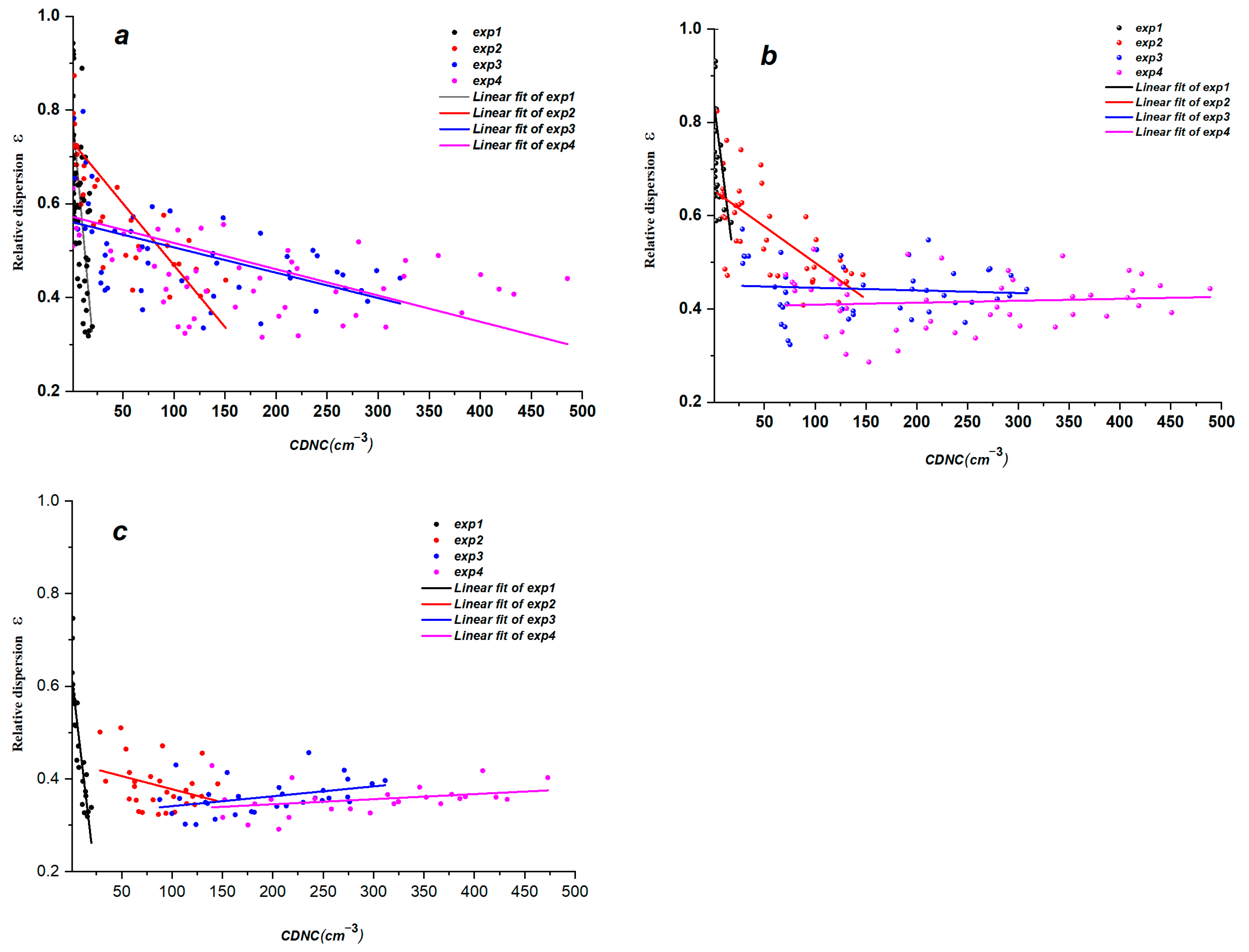
| w ≤ 1.5 m/s | 1.5 ≤ w ≤ 3 m/s | w > 3 m/s | ||||||||||
|---|---|---|---|---|---|---|---|---|---|---|---|---|
| CRNc | CRε | CRr | CRσ | CRNc | CRε | CRr | CRσ | CRNc | CRε | CRr | CRσ | |
| exp1 | 163 | −22 | −26 | −42 | 264 | −4 | −29 | −32 | 303 | −35 | −33 | −57 |
| exp2 | 247 | −18 | −23 | −37 | 353 | −21 | −19 | −36 | 81 | −5 | −9 | −14 |
| exp3 | 409 | −18 | −16 | −31 | 247 | −2 | −16 | −17 | 85 | 8 | −10 | −2 |
| exp4 | 171 | −5 | −11 | −12 | 203 | 4 | −15 | −10 | 99 | 4 | −5 | −1 |
Disclaimer/Publisher’s Note: The statements, opinions and data contained in all publications are solely those of the individual author(s) and contributor(s) and not of MDPI and/or the editor(s). MDPI and/or the editor(s) disclaim responsibility for any injury to people or property resulting from any ideas, methods, instructions or products referred to in the content. |
© 2023 by the authors. Licensee MDPI, Basel, Switzerland. This article is an open access article distributed under the terms and conditions of the Creative Commons Attribution (CC BY) license (https://creativecommons.org/licenses/by/4.0/).
Share and Cite
Yang, S.; Zhang, Y.; Yu, X.; Lu, C.; Li, Y. Effects of Aerosol Number Concentration and Updraft Velocity on Relative Dispersion during the Collision–Coalescence Growth Stage of Warm Clouds. Atmosphere 2023, 14, 828. https://doi.org/10.3390/atmos14050828
Yang S, Zhang Y, Yu X, Lu C, Li Y. Effects of Aerosol Number Concentration and Updraft Velocity on Relative Dispersion during the Collision–Coalescence Growth Stage of Warm Clouds. Atmosphere. 2023; 14(5):828. https://doi.org/10.3390/atmos14050828
Chicago/Turabian StyleYang, Suying, Yanzhe Zhang, Xinyang Yu, Chunsong Lu, and Yiyu Li. 2023. "Effects of Aerosol Number Concentration and Updraft Velocity on Relative Dispersion during the Collision–Coalescence Growth Stage of Warm Clouds" Atmosphere 14, no. 5: 828. https://doi.org/10.3390/atmos14050828




